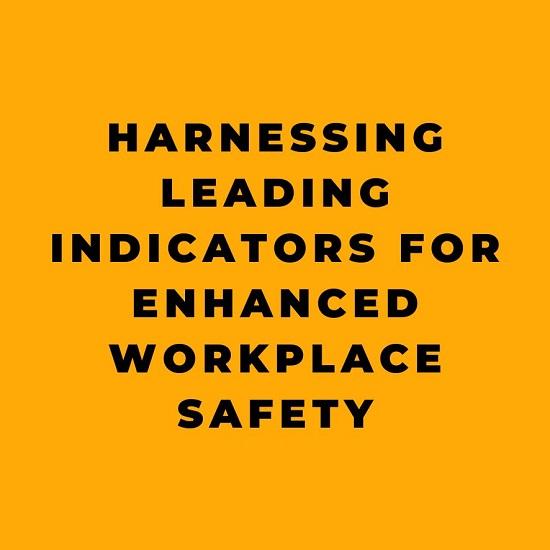Workplace injuries, illnesses, and fatalities continue to impose heavy human and financial costs across industries. However, these adverse outcomes can often be prevented through proactive safety and health programs centered around leading indicators—metrics that provide early warning signs of potential hazards or program inadequacies. Leading indicators allow employers to monitor critical aspects of their safety and health activities, identify deficiencies, and take corrective actions before incidents occur.
The Occupational Safety and Health Administration (OSHA) recommends the use of leading indicators as a vital injury and illness prevention tool that also offers substantial advantages over traditional lagging indicators. This article will provide an in-depth look at leading indicators—what they are, why they matter, and practical guidance on leveraging them to drive safety improvements.
What Are Leading Indicators?
Leading indicators are predictive, preventive metrics that reveal the current effectiveness of safety and health procedures. They track precursors and measure events that can lead to incidents if unaddressed, signaling potential problems in the safety program or emerging hazards.
For instance, a commonly used leading indicator is the ‘time taken to resolve safety concerns raised by employees.’ Consistently missing response time targets signals inadequate hazard control and lack of management commitment, making incidents more likely.
In contrast, lagging indicators are reactive metrics that track retrospectively. They measure actual deaths, injuries, or illnesses that have already occurred due to those unmitigated risks and program deficiencies. While lagging indicators reveal failures after the fact, leading indicators enable early diagnosis and intervention.
Why Leading Indicators Matter
Leading indicators empower employers to find and fix hazards proactively and strengthen safety program elements before adverse outcomes. This prevention-centered approach has pronounced hard and soft benefits:
- Direct cost savings from fewer incidents requiring medical/lost time expenses
- Increased safety perception boosting engagement and retention
- Reduced regulatory penalties and legal liabilities
- Enhanced reputation demonstrating corporate social responsibility
With early risk insights, employers can allocate resources effectively towards hazards elimination over less impactful administrative controls. Overall, leading indicators drive a continuously improving safety culture emphasizing learner attitudes over blaming.
Characteristics of Effective Leading Indicators
For meaningful insights, OSHA recommends leading indicators that are:
Specific: Metrics should track specific hazard control tasks or program improvement actions rather than vague directives. For instance, ‘percentage of safety walks completed’ is better than ‘improve safety walks.’
Measurable: Indicators must be numerical to enable monitoring trends over time towards goals. ‘Number of overdue corrective actions’ is preferable to ‘reduce overdue actions.’
Actionable: Chosen indicators must track aspects that staff can meaningfully impact through their efforts. ‘ Worker-submitted hazard resolution time’ is actionable, ‘reduce incidents’ less so.
Relevant: Metrics must relate directly to and offer insights towards the safety goal. ‘Near-miss reporting rates’ indicate open safety culture more than ‘sales figures.’
Time-bound: Data collection should occur at a useful frequency to reveal trends, not too sparse or onerous. ‘Inspections weekly’ is likely better than ‘annual reviews.’
With purposeful indicators tracking key hazards and program elements, employers can note emerging issues, research underlying causes, and implement process improvements proactively.
Approaches for Developing Leading Indicators
OSHA outlines three flexible approaches to identify and apply leading indicators:
- Monitor Existing Data: Convert metrics already tracked into leading indicators relevant to safety goals
- Control Specific Hazards: Develop metrics focused on mitigating identified risks
- Improve Program Elements: Target indicators towards strengthening safety program components
Employers can choose the methodology best fitting their size, existing systems, predominant hazards, and program maturity. A combination approach is also highly effective.
- Monitoring Existing Data as Leading Indicators
Small businesses just initiating leading indicators may find it easiest to convert readily available data into useful metrics.
For example, a manufacturer tracking quarterly refresher training attendance can set a leading indicator as ‘percentage of workers attending training’ and goal of 100% attendance. Comparing sign-in sheet headcounts to this goal would reveal engagement levels, enabling efforts to understand and remedy poor turnout.
- Controlling Specific Hazards with Leading Indicators
For employers with mature safety programs and well-identified risks, developing indicators to monitor hazard elimination is impactful.
For example, a hospital targeting lift team respond times to reduce patient handling injuries can establish a ‘percentage of lift team arrivals within 5 minutes of calls’ indicator against a 100% goal. Tracking respond times with nursing floor timers would reveal delays needingAdditional lift teams or training could rectify issues.
- Targeting Program Improvement with Leading Indicators
For broad continual improvement, indicators tied directly to OSHA’s recommended program elements are useful:
- Management Leadership: Monitor executive safety review meeting frequency
- Worker Participation: Percentage of employees submitting hazard observations
- Hazard Assessment: Overdue action items from last risk assessment
- Hazard Control: Safety procedure document update timeliness
- Training: Lead times for new hire safety orientations
- Program Evaluation: Completed post-incident report corrective actions
- Communication: Cross-department safety committee coordination meetings
The indicators above offer wide insights into policy, culture, and process efficacy. Lower performance flags areas needing attention to fulfill program potential.
Getting Started with Leading Indicators
While leading indicators offer tremendous incident prevention capability, employers often hesitate unsure where to start. OSHA recommends a simple action plan:
- Review injury causes, hazard walks, and staff surveys to identify serious risks or program weaknesses
- Discuss with frontline teams to select improvement focus areas
- Define goals for those high-priority domains
- Identify leading metric(s) that relate to and offer insight on the goals
- Research historical data availability for those metrics
- Formalize leading indicators, set baseline from historical data, and commence tracking
- Review indicator data vs goals monthly to interpret trends and research underlying reasons
- Identify process adjustments to address underperformance
- Recalibrate baselines and goals once processes stabilize
While just a few meaningful indicators tracked can drive tremendous benefits, integrate additional metrics over time as capabilities advance for a systematized approach.
Key Takeaways
Workplace injuries and illnesses impose immense costs for both employers and employees. Lagging indicators only help analyze adverse outcomes retrospectively without preventing recurrences. Leading indicators provide crucial predictive insights to enable proactive hazard elimination and program improvements driving down incident rates.
Leading indicators are a praiseworthy capability for any workplace but especially those with complex processes, hazardous exposures, regrettable history, or growth ambitions. Global giants like General Electric long evangelized this operational excellence philosophy with the adage “What’s measured improves.” Leading indicators make objective safety measurement possible, enabling fact-based understanding and improvement.
While leading indicators require some initial effort to formalize, data tracking, analytics and process realignments, the minimal effort pays exponential dividends over time. Early warnings reveal minor gaps that are contained with small adjustments rather than festering major vulnerabilities needing reactionary crisis interventions down the line. Just as health metrics help people live longer, leading indicators help organizations become ever safer.










